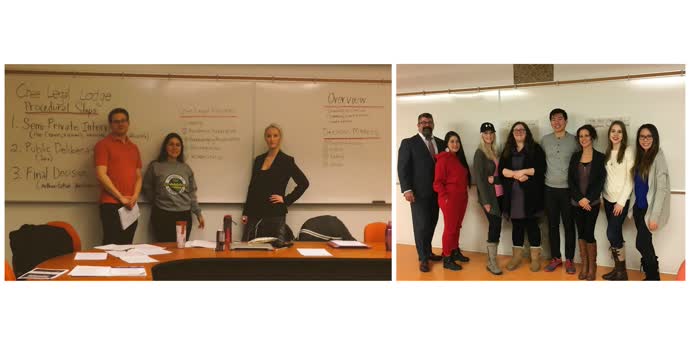
L: Students prepare to begin the moot
R: Dean Paton and Visiting Assistant Professor Hadley Friedland with the students of "Indigenous Laws: Questions and Methods."
Moot court competitions are a proud tradition in law schools, from the traditional appeal format of the Gale Cup to national client counselling and labour arbitration competitions. Blazing a relatively new trail in Canadian law schools, the seven students in Visiting Assistant Professor Hadley Friedland's "Indigenous Laws: Questions and Methods" course were recently given a unique class activity to moot using Cree law.
Friedland, who first taught the course as an intensive spring seminar at McGill Law as an O'Brien Fellow, said the case she chose for the moot - students spent weeks preparing to argue their positions and acted as decision makers for the case - was particularly difficult.
"It was a complex domestic violence case involving addiction, a long-term relationship, complicated community dynamics and children," she said, adding that domestic violence is a pressing issue both in Canadian society and in indigenous communities.
"I don't want to shy away from the tough stuff," she said.
Friedland's course tackled difficult topics. In the first half of the term, students looked at legal theory and explored topics such as residential schools and intergenerational trauma. Students then looked at the challenges of learning indigenous laws and the legal methods that can be used to engage with them seriously and respectfully. The final part of the course, in preparation for the moot, looked at substantive work in Cree law.
"Student feedback about the course has been overwhelmingly positive - some have called it transformative," said Friedland, noting that students have also told her they not only feel they understand indigenous law better, but all law.
"The addition of Dr. Friedland's course on indigenous laws, the January 2017 launch of a new 'Gladue' experiential learning opportunity that will be the first of its kind in Canada, and the inclusion of introduction to indigenous legal traditions for all first-year students as part of the Foundations of Law course are just three ways that UAlberta Law is responding to the recommendations of the Truth and Reconciliation Commission that the Federation of Law Societies of Canada and Canadian law schools ensure that lawyers receive appropriate cultural competency training, including in the history and legacy of residential schools, the UN Declaration on the Rights of Indigenous Peoples, Treaties, and Aboriginal rights," said Dean Paul Paton.
"We have much yet to do, but are steadfast in our commitment to ensuring that our law students enter the legal profession with knowledge of indigenous laws and legal traditions, a firm understanding of the application of Canadian law to Indigenous peoples, and the skills to interact with respect and understanding with people from a variety of indigenous societies. Including an examination of these issues in our curriculum is incredibly important - not just for students' legal competency, but also because of our shared responsibility as officers of the court and our role as leaders in Canadian society."
Grace Cleveland was a student in the class who said she found the moot beneficial.
"The Cree law moot proved that indigenous legal traditions are fully capable of being applied to complex and contemporary issues. This process was inspiring for all of us and I think it can be inspiring and empowering even for those not involved with the course," she said, adding that indigenous laws can be as relevant and useful as common or civil law.
In preparation for the moot, students were asked to write factums representing a party in the case and develop a legal process for a hypothetical "Cree Legal Lodge" based on Cree procedural principles. Developing a fair and legitimate process for the adjudication of a case is another unique aspect of this particular moot which reflects the rebuilding of justice processes taking place within indigenous legal traditions today. The final component of the moot was a take home exam where each student wrote a judgment for the case they heard.
"Watching the students moot was amazing," said Friedland. "I am blown away by the quality of the students and how much time and effort they put into the work."